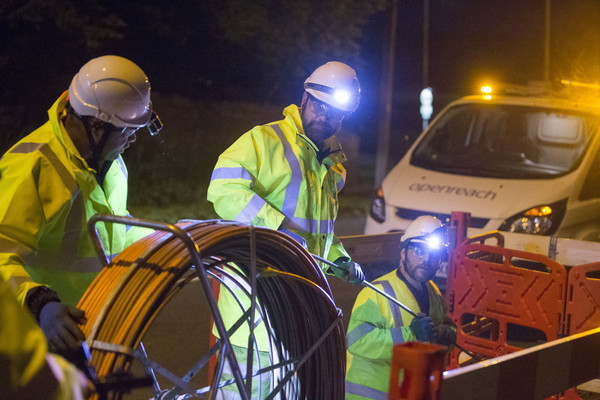BT’s access division, Openreach, is trialling new tools and techniques to bring fibre to the premises (FTTP) broadband to remote locations.
The company says the pilot in the Lancashire villages of Hesketh Bank and Parbold will pave the way for a much bigger upgrade of rural homes and businesses in smaller, less accessible locations.
Approaches being tested include a ‘diamond cutter’ trench-digging tool. The giant rotating circular blade with diamonds embedded in the metal coating on its edge can slice through pavements and roads leaving a neat channel into which the machine simultaneously feeds in tubing for fibre-optic cables.
The tool can install 700 metres of cabling a day – more than 20 times the amount possible by a two-person team using drilling and excavation. Openreach says this could slash the time taken to deploy fibre by months.
Remote nodes
The company is also trialling ‘remote nodes’ – where fibre-optic cables can be built out from specially adapted existing green roadside cabinets. Equipment installed inside the cabinet enables full-fibre connections to extend their current reach by more than 1.5 times, with the capacity to connect more than 1,000 premises.
By ‘piggy-backing’ on the existing network, Openreach says engineers can avoid up to six months in time and associated cost involved in deploying new fibre cables from an exchange to remote rural areas.
Openreach said some homes and businesses could receive FTTP in time for Christmas. Once services are live, residents should see download speeds of up to 1 gigabit per second (1Gbps).
Clive Selley, Chief Executive of Openreach, commented, “At Openreach, we’ll never be just a city fibre provider. We’ve always worked hard to improve connections to isolated, less commercially attractive communities through inventive engineering and effective funding partnership models.”
Fibre First
He added: “In recent years we’ve been extending our full-fibre network into rural areas – mostly in partnership with local authorities and Government – but the economics are clearly challenging and we want to do more. We know that around 10% of the country will need to the support of public subsidy, but these trials will help us test a bunch of new techniques that could help us in other rural areas.
“The trials will also give us a much clearer picture of what the technical challenges in these kinds of rural areas are. We hope they’ll go a long way towards developing the tools, skills and innovations required to make sure that nobody’s left behind in the full-fibre future.”
The pilot could make areas eligible that were less commercially viable for Openreach’s ‘Fibre First’ investment programme, “if the right investment conditions are met,” the company said.



